Seated on a bed against a bright purple wall, Canon Cunningham inspects a wig of long, wavy, mermaid-blue hair. Running a brush through the bright locks, the youth (who goes by the pronouns “they/them”) is intent on the task at hand.
Earlier this year, when St. Albert Pride threw an inclusive prom event, Canon donned a fancy dress – a spectacular black-and-white leopard print affair – and joined LGBTQ+ youth from across the city in celebrating their identity.
Canon isn’t sure yet what that identity is, but the young St. Albert activist is figuring that out at their own pace.
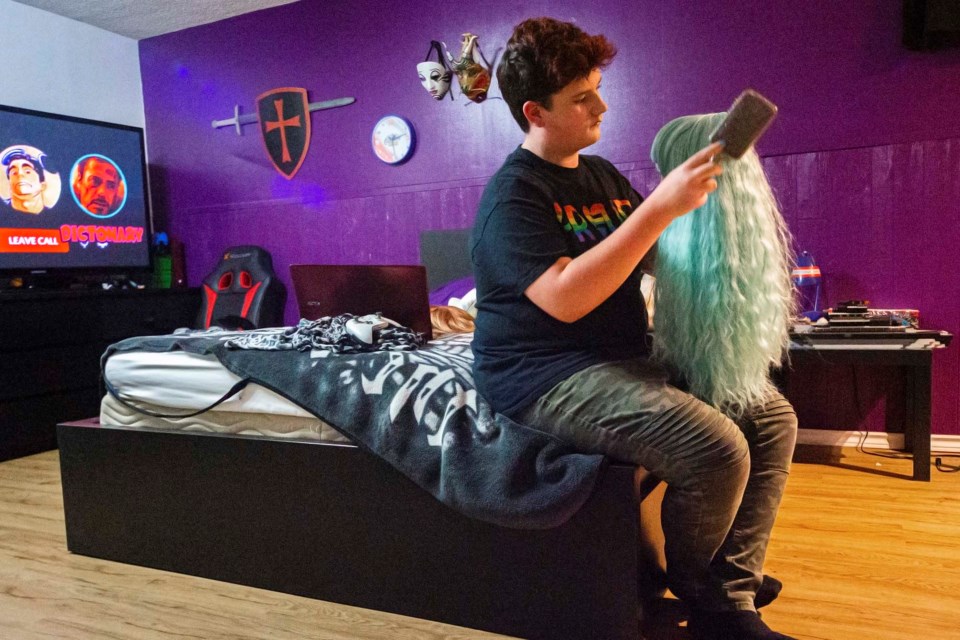 Canon takes a moment to brush out the many wigs in a collection that offers a variety of styles. CHRIS COLBOURNE/St. Albert Gazette
Canon takes a moment to brush out the many wigs in a collection that offers a variety of styles. CHRIS COLBOURNE/St. Albert Gazette“A bit of an awkward conversation”
Canon knows what it feels like to be a stranger in one’s own body. They struggled with suicidal thoughts and devastation over a physical body that was becoming more and more male. Their family grappled with Canon’s changing identity and what it would mean for the youth’s future.
While some of those struggles are far from over, today Canon is a happy, healthy St. Albert youth. The 14-year-old has found a place to belong and a supportive community – and a voice they can use to reach other kids who are hurting.
Born male, Canon spent most of their young life as male. But early on, the youth began to feel different from other kids – and with that feeling came fear, shame and confusion.
“It’s just, something didn’t feel right. So I was like, ‘What is it? What’s wrong with me?’ ” Canon said of the beginning of their journey of self-discovery.
Trying to understand what was happening, Canon finally came out as gay at the beginning of Grade 7. They were 12 years old.
It was a big step for the youth, who worried about how their family would react – even though their family is loving and supportive.
“I never really wanted to come out, because I knew that it was something to do with my sexuality … I (didn’t) want to tell anybody else what’s happening,” Canon said.
“It’s just scary.”
As time progressed, Canon realized they were struggling to identify as male. About a year after coming out as gay, the youth realized they wanted to come out as trans.
Staring down the barrel of a difficult conversation with their mom about their body, Canon backed away from that label until earlier this year.
“I found it hard – I didn’t really identify with my born gender, male. So I identified as female. And it was a bit of an awkward conversation,” they said.
“I was like, ‘I think I might be trans – but like, for real this time.’ … We talked about being trans, and because I came out quite a little bit later than I should have, there was lots of things that I’ve already gone through, like my voice got deeper and stuff like that. So we started trying to get in to doctors to start the process of being trans.”
Crystal Holberton, Canon’s mom, said she immediately began to look at getting medical help for her child. But as the months went on, Canon was unsure about starting testosterone blockers and estrogen. They are still discovering their identity.
“I’ve come out as multiple things, many times,” Canon said. “Every time that I find something new, it’s like I’ve got to come out to them again.”
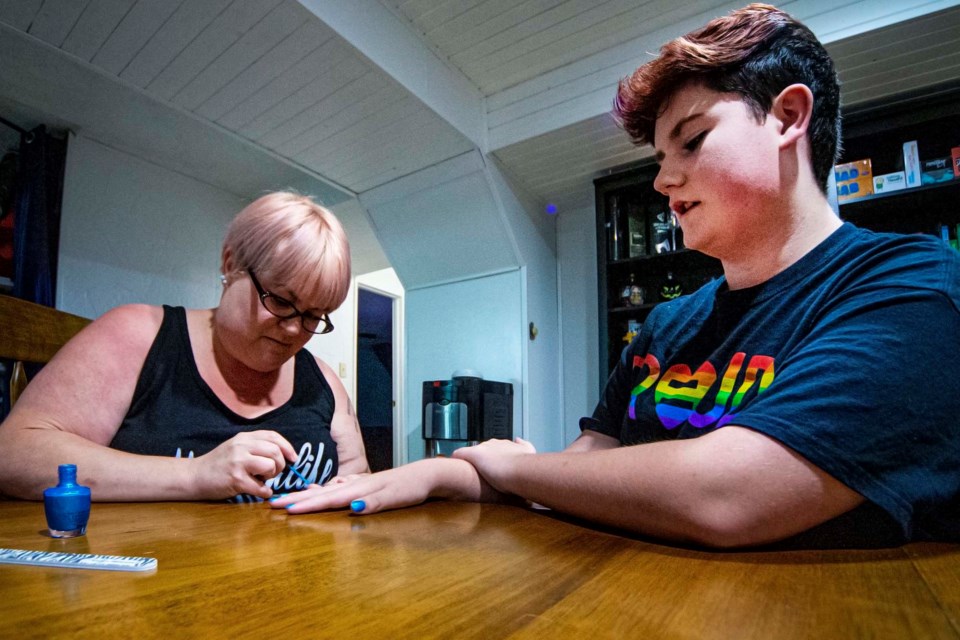 Canon's mom Crystal helps touch up some freshly painted nails at the family's home in St. Albert. CHRIS COLBOURNE/St. Albert Gazette
Canon's mom Crystal helps touch up some freshly painted nails at the family's home in St. Albert. CHRIS COLBOURNE/St. Albert GazetteGirl or boy – and why it matters
Not being able to fit neatly into the typical male-female gender binary brings Canon a level of distress. They feel a strong desire to figure out if they want to be a girl or a boy, instead of hovering in a space of daily uncertainty.
“I do find it kind of hard not to identify with a label. But there is lots of people that just don’t identify with a label, just like queer or non-binary … I want to label, I want to be male or female, or gay or straight,” they said.
“I want to figure it out, and I want to know what I am because I struggle not knowing. It’s just a difficult journey.”
The struggle brings with it a loneliness that, in the past, has driven Canon into the depths of depression.
“At one point, I was very suicidal, because I didn’t know what was happening to me. So I just felt like if I could just harm myself or take all the pain away, it would just be so much better. I felt like not living any more was a better option than just coming out,” they said.
“My mom is so supportive, and all my family would accept me, but it was just so scary and I felt so alone and isolated. And I didn’t know how to deal with it.”
They would lay awake at night crying, feeling their Adam’s apple and their square jaw as their body changed to look more masculine, every day growing more alien from the gender they felt inside.
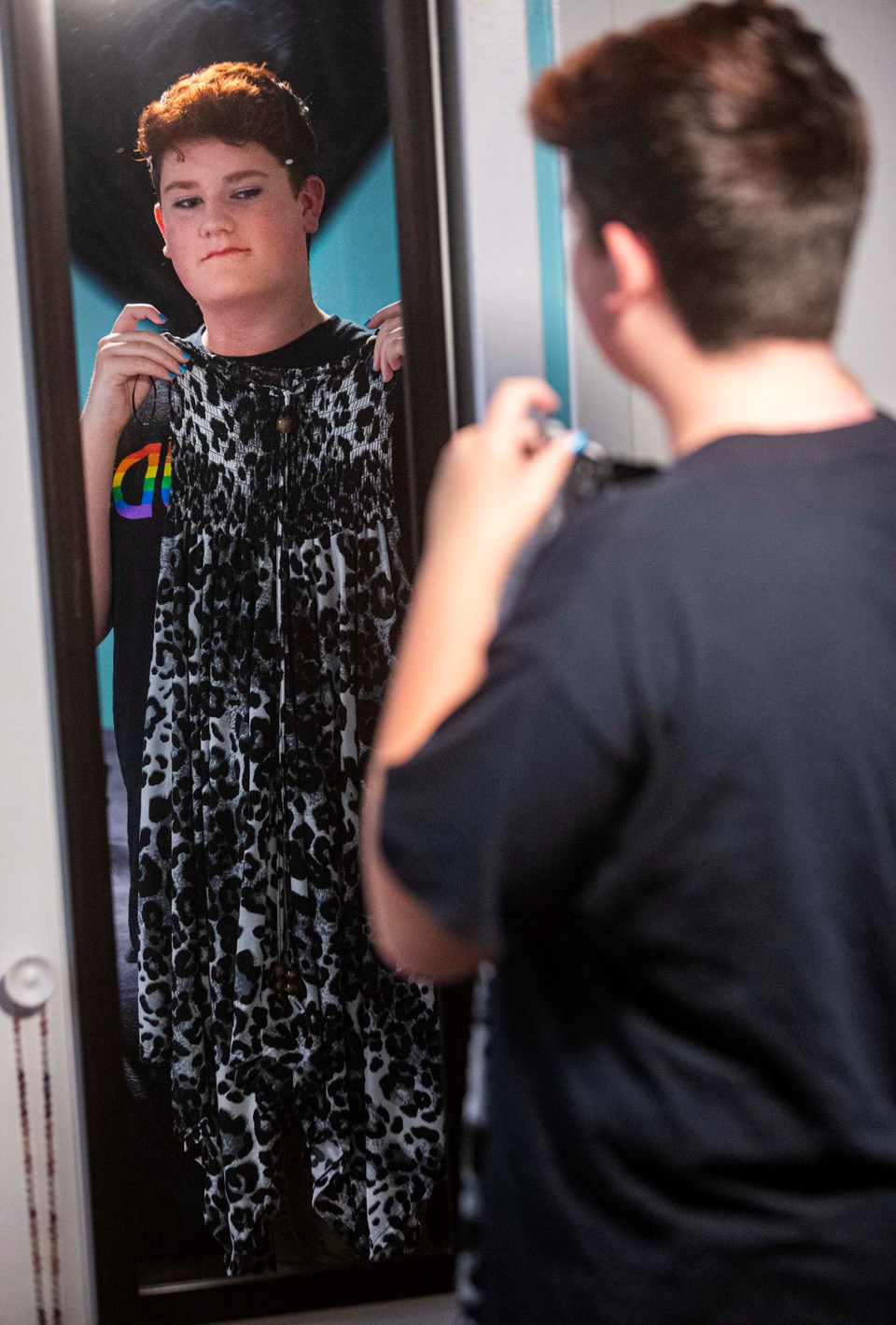 Canon has spent years trying to decipher and understand the changes that have led them to identify as non-binary and credits a loving and supportive family for helping along the way. CHRIS COLBOURNE/St. Albert Gazette
Canon has spent years trying to decipher and understand the changes that have led them to identify as non-binary and credits a loving and supportive family for helping along the way. CHRIS COLBOURNE/St. Albert GazetteThe mental toll of not fitting in
There are harrowing statistics around LGBTQ+ youth and mental health struggles.
A 2015 study on trans health (Being Safe, Being Me in Alberta: Results of the Canadian Trans Youth Health Survey) showed nearly three-quarters of trans youth who responded reported self-harm.
Another 67 per cent of youth reported having thoughts of suicide, and more than two in five said they had attempted to take their own lives (41 per cent for younger youth in the year before the study, and 38 per cent for older youth in their lifetime.)
Kris Wells, a St. Albert resident and an associate professor at MacEwan University who is a Canada Research Chair in Sexual and Gender Minority Youth Issues, says those statistics come down to trans and non-binary youth not feeling safe, included and accepted in the community.
“We know that these young people can be some of the most at-risk youth in our communities, and the most vulnerable. So you know, it really caused us to pay attention more closely to their experiences and the kinds of policies and practices we’re engaging within our community,” he said.
Part of the challenge comes from the words we have traditionally used to describe gender and sexuality.
“It’s the power and curse of language. Language helps us to understand and explain our feelings and thoughts, but in some ways, you know, language is so limiting,” Wells said.
“Right now, we feel so much pressure in particularly young people going through their adolescence, which is that key identity formation period, struggling to find a place where they can belong. There’s so much pressure to fit in and conform to norms and peer groups, and to gain that acceptance, particularly in our schools, that if you don’t identify that way it can be very challenging.”
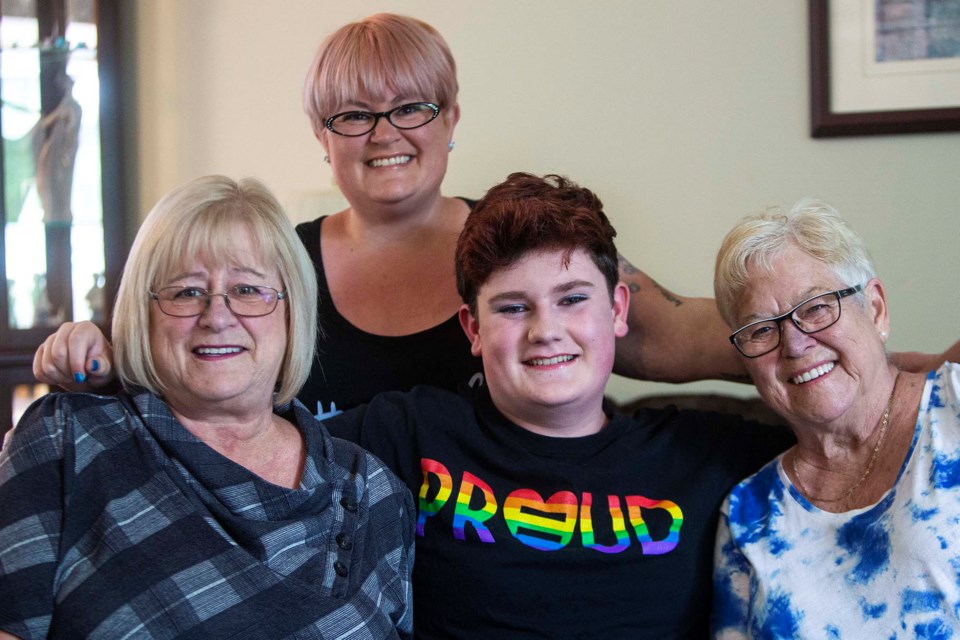 Grandmother Kathy McLeod, left, mom Crystal Holberton, Canon Cunningham, 14, and great-grandmother Ruth McLeod. CHRIS COLBOURNE/St. Albert Gazette
Grandmother Kathy McLeod, left, mom Crystal Holberton, Canon Cunningham, 14, and great-grandmother Ruth McLeod. CHRIS COLBOURNE/St. Albert GazetteSupporting her child
Canon’s struggle is reflected within their family. Watching her child suffer through their journey of self-discovery hasn’t been easy for Holberton – especially when Canon struggled with suicidal thoughts.
Holberton said she turned into a “bulldog” parent, pushing through the medical system in her search for the proper support and help. She also worries about Canon’s overall safety, especially at a time when she feels rights are being rolled back for LGBTQ+ people.
She said the recent political climate in Alberta following the latest provincial election, with the new UCP government having changed rules governing gay-straight alliances in schools, troubles her.
“My child is coming out in a time that is scary. If he wears a dress to school, is my child going to get beat up? If he decides to walk to the store with his friends at lunchtime, is somebody going to pull over and beat him up walking down the street, because if he’s wearing a dress and has that haircut, and whatever, it’s very obvious that there’s something going on,” she said.
“So there is that fear.”
Navigating the health system has been no walk in the park, she said. When Canon was feeling suicidal and they needed help immediately, Holberton was frustrated to find out the system moved slowly.
She recalls their family doctor looking like a “deer in the headlights” when she disclosed Canon’s struggles, prompting her to research doctors who support trans youth.
She found out the closest one was at the University of Alberta – a distance she found frustrating – and once Holberton found a GP, it took weeks for them to be referred to a gender clinic to see a psychologist.
Once Canon sees the psychologist, they can then be referred to a psychologist, who then needs to refer them to an endocrinologist for testosterone blockers.
Holberton knew they couldn’t wait the weeks or months for help.
“You go in and say, ‘If my child doesn’t get help, I might not have a child.’ So if you walk in there and are not a pushy mother like I am, it could be months,” Holberton said.
Her pushiness got Canon put on the emergency list.
The 2015 study on trans health documented how difficult it can be for trans and non-binary youth to find proper medical care. Half of youth said their current family doctor knew about their trans identity, but only 15 per cent felt “very comfortable” discussing their trans status and related health care needs. Only three per cent felt comfortable at walk-in clinics.
Even as she supported Canon, Holberton said she struggled with a sense of loss.
“If you get into the parenting trans community at all, almost every parent feels a loss, like they’re losing their child,” Holberton said.
She eventually realized she was actually grieving the loss of the future she had envisioned for Canon, and the feeling of loss went away: she could handle losing the picture of the future she had painted for her child, and was just happy Canon was still there with her.
Despite the hardships, Holberton said it has also been a privilege to travel Canon’s path with them.
“The best part of it is watching my child go from this hurting, suicidal little boy into this blossoming, amazing human that’s going to change the world. And I believe that,” she said.
“I think my baby’s beautiful no matter what, and I just want him to be confident in who he is or whatever he chooses.”
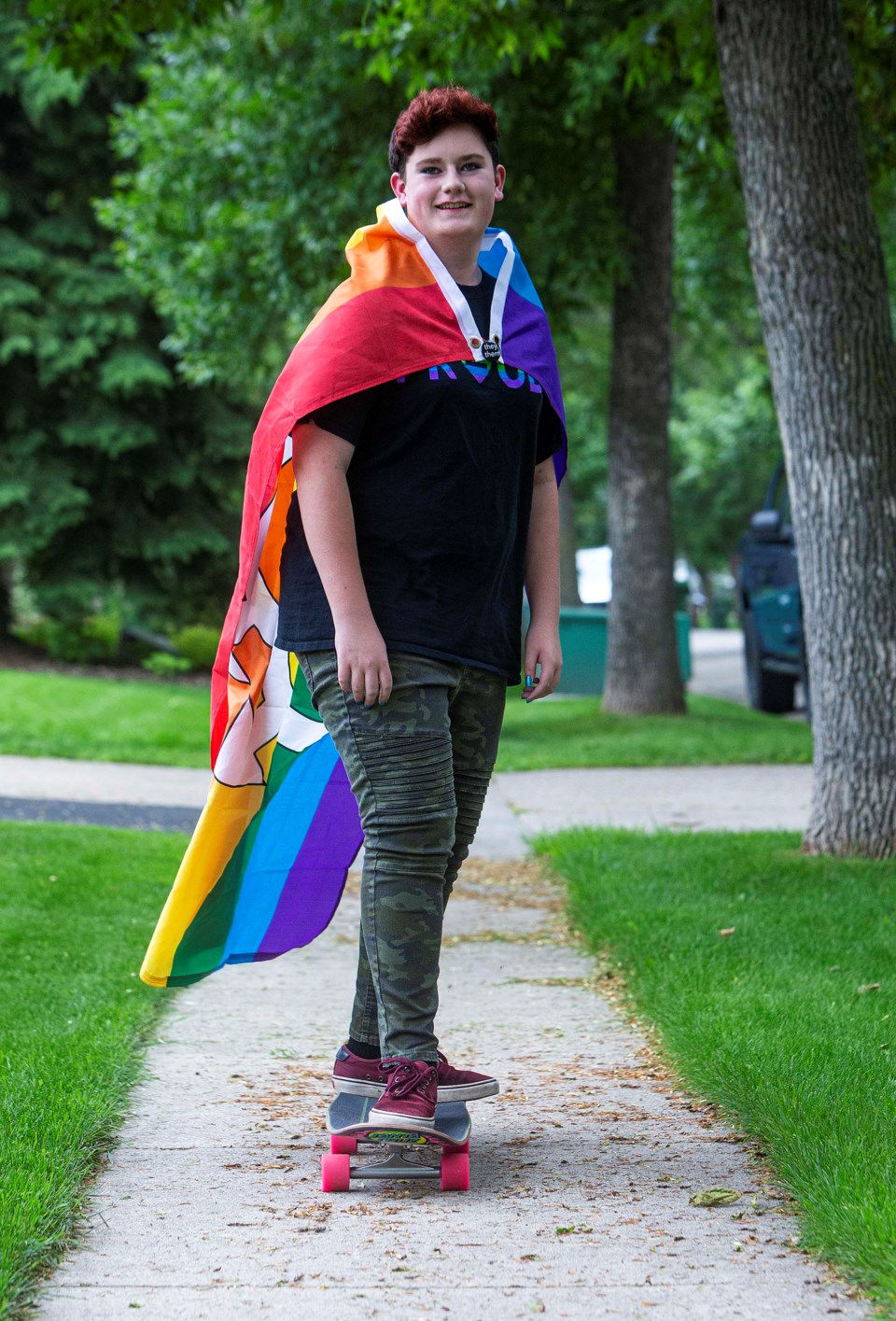 Canon said there have been difficult and emotionally trying times but they have a more positive feeling about the future. CHRIS COLBOURNE/St. Albert Gazette
Canon said there have been difficult and emotionally trying times but they have a more positive feeling about the future. CHRIS COLBOURNE/St. Albert GazetteFinding a community
Long before they came out, Canon struggled with being bullied, and was homeschooled for part of Grade 3 and again for the entire Grade 6 year.
“I moved schools quite a bit when I was in elementary,” they said.
Eventually, though, Canon found a home at W.D. Cuts, where friends and staff have been extremely supportive. He has a favourite teacher, Andrew Wiens, who is involved with the LGBTQ community, who he can go to if he ever needs to talk.
Wiens also runs a gay-straight alliance at the school, where Canon has found other kids who are going through similar challenges.
“Having people to talk to, it changes everything,” they said.
Holberton said she was “pleasantly surprised” when she met with the school before Canon started classes there.
“They just really stepped up,” she said, adding they created gender-fluid bathrooms and safe change spaces for Canon.
The school also worked closely with Canon and Holberton to tackle any issues of bullying, and check in regularly with the family.
When Canon decided to change their pronouns, the school was immediately on board.
“They truly did everything they can, and continue to do so,” Holberton said.
Inside the school, through the gay-straight alliance and through Outloud, Canon has found support from new friends.
“My friends could care less. They’re like, ‘Okay, whatever, you’re still Canon,’ ” the youth said.
Support for Canon also pours out from all members of their family. Even Holberton’s more socially conservative family members who used to believe gay people were going to hell and transgender people were abominations have softened their views, expressing unconditional love for Canon.
Holberton and Canon live with Holberton’s mom, Kathy McLeod, and grandmother, Ruth McLeod, who both adore and support Canon, as does Canon's stepfather, Craig Holberton.
Kathy said she has seen a sense of peace come over Canon since they came out as trans.
Canon and Holberton have also been attending Outloud, a local group for LGBTQ+ youth and PFLAG, a group for families and parents of the LGBTQ+ community, which have helped them both feel less alone.
“I couldn’t imagine my life without it. Parents need to know that it’s out there. We need to help these families,” Holberton said.
“I can’t tell you how many Tuesday nights I sat in that room and bawled my face off, asking, ‘How do I keep my kid alive?’ ”
Attending the group has also given them exposure to other youth struggling with gender identity, many of whom do not have supportive families. Some hide their identities from their parents out of fear of being kicked out, abused or mistreated; others have come out to their parents but their families refuse to recognize their preferred gender.
Holberton said supportive families and the medical community need to step up to save these youth.
“Imagine what they’re feeling, and then imagine being unsupportive of that.”
Wells said family support is critical for trans and non-binary people.
“It’s really important that as this young person goes on a journey, their family goes on a journey as well, and the family is there beside them, supporting them and learning alongside them,” he said.
Speaking out to save lives
Some days, Canon wakes up and dresses more feminine. Other days, they feel more masculine and want to look like a boy.
Although they have come a long way from wanting to end their life, they still struggle with their gender identity.
But their biology isn’t waiting for them to figure it out.
“I just don’t want to look like a gender right now, because … I don’t know if I’m a female, male, non-binary. So if I just go with non-binary, it’s not that hard to just be male or female whenever I want. But if I have those masculine features, it’s hard to just not look male,” they said.
Still, Canon perseveres through life’s difficulties. This year’s Pride Week was the first time they went out in public wearing a dress.
Now, Canon and their family want to help other kids who face similar challenges feel less alone. Canon speaks at schools about their experience and is a young LGBTQ+ activist helping to teach people about being non-binary.
Wells said young activists like Canon are incredibly important to help change how the world perceives gender.
“They’re telling us to pay attention. They are bringing us an impending revelation about how we’ve understood gender, and why that needs to change,” Wells said.
Holberton said now that Canon has begun to feel more confident, they are finally able to help others on the same journey.
“Canon had to come from a place where they had hope to offer, because the only feeling that kills suicidal thoughts is hope,” she said.
“If one kid reads this article, or sees this interview, and is given that one little spark of hope, it literally could save a life.”
Canon said they felt so alone for so long, struggling silently to figure out who they are.
“If I could just reach out to even just a few kids, and they hear this, and it’s like, ‘I’m not alone.’ I can save somebody,” they said.
Anyone interested in connecting with Outloud or any members of the LGBTQ+ community and their allies who are needing support or resources can find more information at www.outloudstalbert.ca, find them on Facebook or reach them at 780-990-6518.
Anyone having thoughts of suicide should call Health Link at 811 or the Mental Health Help Line at 1-877-303-2642, which is available 24 hours a day, 7 days a week.
Definitions
While many people self-identify using different terms, these definitions from Alberta Health Services may help contextualize the terms used in this article, which are reflective of Canon’s personal experience. Other definitions can be found at transstudent.org:
Sexual orientation
Describes a person’s emotional and/or sexual attraction to others.Gender Identity
One’s internal, deeply held sense of one’s gender. For transgender people, their own internal gender identity does not match the sex they were assigned at birth. Some people have a gender identity of man or woman (or boy or girl). For some people, their gender identity does not fit neatly into one of those genders. They may identify as agender, without gender, among other terms.Gender Expression
External and public presentation of a person’s gender expressed through one's name, pronouns, clothing, haircut, behaviour, voice, or body characteristics. Gender expression also includes using facilities (such as washrooms and change rooms) that correspond with their own sense of gender.Gay
A person who has emotional or sexual attraction to people of the same sex or gender. This term is most often used for a male who has emotional or sexual attraction to males.Heterosexual (Straight)
A person who has emotional and/or sexual attraction to people of the opposite sex or gender, to their own.Gender Fluid
The gender identity, behaviours and appearance of a person moves along a gender spectrum and/or challenges gender restrictions and norms. Related terms can include gender queer, gender non-conforming, gender neutral, pangender, tri-gender, agender, non-binary gender.Transgender (Trans, Trans-identified)
An umbrella term for people whose gender identity and/or gender expression differs from what is typically associated with the sex they were assigned at birth. Not all people identify as transgender and some people may describe themselves using one or more of a wide variety of terms.



